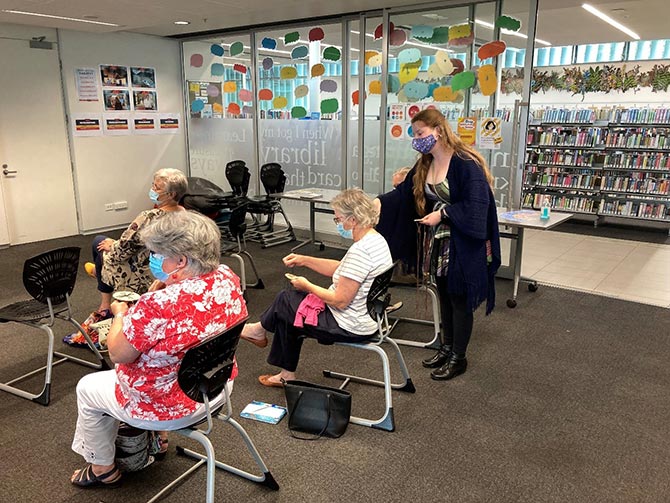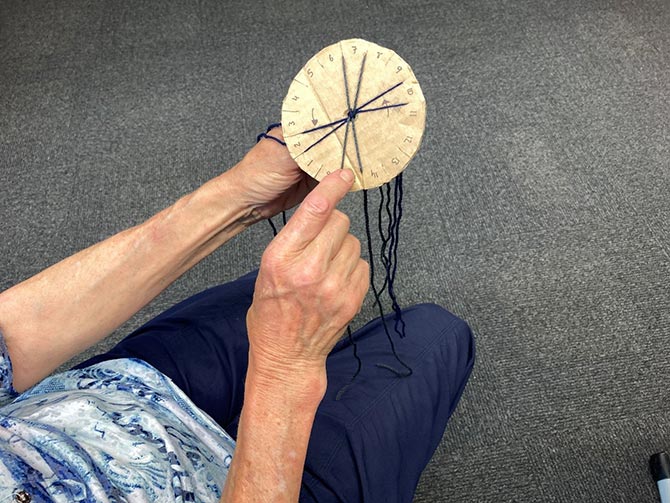Sally reports back from the last Craft Snippets event at Upper Riccarton library with featured crafter, Tiffani who does weaving and braiding. The next Craft snippets event will be at 6.30-7.30pm Wednesday 30 March and will feature felter Jane Dolan.
A small group of keen people came out on Wednesday evening to listen to weaver Tiffani talk about the art of medieval braiding. She brought along examples of fingerlooped braids, regular braids, lucet braid, and trollen braiding.
The first form of braiding Tiffani showed us was using a lucet fork (lucet). This makes a square cord which is great for lacing and less prone to slipping than a round cord. Unlike other forms of braiding, lucet cord is created from a single strand. This can be easier to work with for creating long cords as you don’t need to measure and cut the strands prior to beginning the braid but rather can simply keep going until the cord has reached the desired length.
Lucet cording is thought to have originated around Scandinavia and old examples of lucets have been found in archaeological digs from as long ago as the 12th Century. These pieces are made of bone, with the cord able to be fed through the hollow centre as it is woven. Unfortunately, the nature of braided cord of any form (biodegradable and well used) means that there are no known examples of lucet cording itself. An advantage of using a lucet over other forms of braiding is that you don’t have to measure the warp, i.e. pre-measure and cut the thread you will be using to create the braid.
The second form of braiding Tiffani demonstrated was using what she refers to as a Trollen wheel or a braiding wheel. The cords made in this style are very strong due to the number of strands that can be used; the examples Tiffani showed were made from 8-strands. Many people believe that Trollen weaving came from the Vikings but there is no known hard evidence of this. The earliest evidence of a form of braiding wheel in Western Europe dates to the 17th Century and continued to be popular until the Industrial Revolution. Trollen wheels are markedly similar to a Japanese style of braiding cord called kumihimo which dates back to the 8th Century so perhaps the technique simply migrated as trade increased.
Tiffani talked about how she was introduced to medieval braiding through workshops at the Abbey Medieval Festival in Brisbane. The Festival is one of the largest of its kind in the Southern Hemisphere and brings together people re-enacting different cultures and periods spanning from 600AD to 1600AD. Tiffani and her family went every year and attended different workshops such as Morris dancing and braiding.
Nalbinding was another old fibre art form that was taught at the Abbey Medieval Festival and one of the books on display was “With one needle: How to Nalbind”. This is a very old technique using one needle, is very hard wearing and doesn’t come undone as each stitch is essentially knotted. One of the oldest archaeological examples of nalbinding was a textile fragment dating to 6500BC found in Israel. One of the oldest complete examples, a pair of red socks, dates to 350AD-500AD and was found in Egypt.
Someone asked what people used for yarn and Tiffani said yarn could be made from the fibres of sheep, yaks, goats, flax, silk and cotton or other plant fibres, even human hair! Basically, anything with a long fibre that could be spun could be used based on regional availability.
Someone mentioned a report on the radio about a children’s shoe from Roman times being found in a peat bog near Hadrian's Wall and asked whether the lacing might have been this type of cord. Tiffani thought they would most likely have used leather or rawhide straps for shoes or waxed cord but wasn’t certain.
Tiffani demonstrated how to use both the Trollen wheel and Lucet fork. Braiding using the Lucet fork doesn’t tangle as much due to only using one strand. Tiffani finds it very meditative and often braids while watching movies.
Tiffani then handed out some Trollen wheels she had made with cardboard and taught us how to do this ancient form of braiding. The wooden wheel Tiffani was using had 32 notches. The cardboard ones had 16 so a little easier to use. We have done a form of this with children using a wheel with only eight notches. Everyone had a go and took their wheel home.
If you are keen to have a go and would like a wheel, we can organise one to be made for you using the library laser cutter on a koha (donation) basis. If you are keen to have a go and would like a wheel, email us at library@ccc.govt.nz. Tiffani is more than happy to run a session in the future on how to use these ancient forms of braiding.
New crafting titles
Angela did a round up of the latest crafting books and magazines in the Library including two new ones, a new knitting journal called Laine and a new embroidery journal called Love Embroidery.
Do pop a hold on any you are keen to borrow.
New items shared at our January gathering.
View Full List
Upcoming craft events
We did a round up of what is on in Christchurch including:
- Night classes available through Risingholme held at Riccarton High School
- WEA have started their classes for the year and have a range of classes and crafting groups.
- Classes available at Handzon in Rangiora including some great crochet alongs. You can check out the classes on offer here.
- If you are keen on knitting and crochet classes but need to learn the basics, there are people who can teach for free at the Upper Riccarton Library knit 'n' yarn sessions on Tuesday afternoons and Thursday mornings.
Our next Craft Snippets is on Wednesday 30 March and will feature felter Jane Dolan. Do keep an eye out for more information about this great upcoming talk.





Add a comment to: Craft Snippets: Medieval braiding